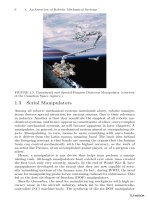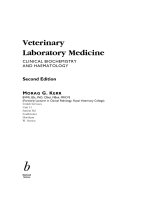Fundamentals of Robotic Mechanical Systems: Theory, Methods, and Algorithms, Second Edition doc
Bạn đang xem bản rút gọn của tài liệu. Xem và tải ngay bản đầy đủ của tài liệu tại đây (10.07 MB, 545 trang )
Fundamentals of Roboti
c
Mechanical Systems:
Theory, Methods, and
Algorithms,
Second Edition
Jorge Angeles
Springer
TLFeBOOK
Mechanical Engineering Series
Frederick F. Ling
Series Editor
Springer
New York
Berlin
Heidelberg
Hong Kong
London
Milan
Paris
Tokyo
TLFeBOOK
Mechanical Engineering Series
J. Angeles,
Fundamentals of Robotic Mechanical Systems:
Theory, Methods, and Algorithms, 2nd ed.
P. Basu, C. Kefa, and L. Jestin,
Boilers and Burners: Design and Theory
J.M. Berthelot,
Composite Materials:
Mechanical Behavior and Structural Analysis
I.J. Busch-Vishniac,
Electromechanical Sensors and Actuators
J. Chakrabarty,
Applied Plasticity
G. Chryssolouris,
Laser Machining: Theory and Practice
V.N. Constantinescu,
Laminar Viscous Flow
G.A. Costello,
Theory of Wire Rope, 2nd ed.
K. Czolczynski,
Rotordynamics of Gas-Lubricated Journal Bearing Systems
M.S. Darlow,
Balancing of High-Speed Machinery
J.F. Doyle,
Nonlinear Analysis of Thin-Walled Structures: Statics,
Dynamics, and Stability
J.F. Doyle,
Wave Propagation in Structures:
Spectral Analysis Using Fast Discrete Fourier Transforms, 2nd ed.
P.A. Engel,
Structural Analysis of Printed Circuit Board Systems
A.C. Fischer-Cripps,
Introduction to Contact Mechanics
A.C. Fischer-Cripps,
Nanoindentation
J. García de Jalón and E. Bayo,
Kinematic and Dynamic Simulation of
Multibody Systems: The Real-Time Challenge
W.K. Gawronski
, Dynamics and Control of Structures: A Modal Approach
K.C. Gupta,
Mechanics and Control of Robots
J. Ida and J.P.A. Bastos,
Electromagnetics and Calculations of Fields
M. Kaviany,
Principles of Convective Heat Transfer, 2nd ed.
M. Kaviany,
Principles of Heat Transfer in Porous Media, 2nd ed.
E.N. Kuznetsov,
Underconstrained Structural Systems
(continued after index)
TLFeBOOK
Mechanical Engineering Series
(continued from page ii)
P. Ladevèze,
Nonlinear Computational Structural Mechanics:
New Approaches and Non-Incremental Methods of Calculation
A. Lawrence,
Modern Inertial Technology: Navigation, Guidance, and
Control, 2nd ed.
R.A. Layton,
Principles of Analytical System Dynamics
F.F. Ling, W.M. Lai, D.A. Lucca,
Fundamentals of Surface Mechanics With
Applications, 2nd ed.
C.V. Madhusudana,
Thermal Contact Conductance
D.P. Miannay,
Fracture Mechanics
D.P. Miannay,
Time-Dependent Fracture Mechanics
D.K. Miu,
Mechatronics: Electromechanics and Contromechanics
D. Post, B. Han, and P. Ifju,
High Sensitivity Moiré:
Experimental Analysis for Mechanics and Materials
F.P. Rimrott,
Introductory Attitude Dynamics
S.S. Sadhal, P.S. Ayyaswamy, and J.N. Chung,
Transport Phenomena
with Drops and Bubbles
A.A. Shabana,
Theory of Vibration: An Introduction, 2nd ed.
A.A. Shabana,
Theory of Vibration: Discrete and Continuous Systems,
2nd ed.
TLFeBOOK
Jorge Angeles
Fundamentals of Robotic
Mechanical Systems
Theory, Methods, and Algorithms
Second Edition
123
TLFeBOOK
Jorge Angeles
Department of Mechanical Engineering
and Centre for Intelligent Machines
McGill University
817 Sherbrooke Street
Montreal, Quebec H3A 2K6, Canada
Series Editor
Frederick F. Ling
Ernest F. Gloyna Regents Chair in Engineering
Department of Mechanical Engineering
The University of Texas at Austin
Austin, TX 78712-1063, USA
and
William Howard Hart Professor Emeritus
Department of Mechanical Engineering,
Aeronautical Engineering and Mechanics
Rensselaer Polytechnic Institute
Troy, NY 12180-3590, USA
Library of Congress Cataloging-in-Publication Data
Angeles, Jorge, 1943–
Fundamentals of robotic mechanical systems : theory, methods, and algorithms / Jorge
Angeles.—2nd ed.
p. cm.—(Mechanical engineering series)
Includes bibliographical references and index.
ISBN 0-387-95368-X (alk. paper)
1. Robotics. I. Title. II. Mechanical engineering series (Berlin, Germany)
TJ211 .A545 2002
629.8'92—dc21 2001054911
ISBN 0-387-95368-X Printed on acid-free paper.
© 2003 Springer-Verlag New York, Inc.
All rights reserved. This work may not be translated or copied in whole or in part without the written
permission of the publisher (Springer-Verlag New York, Inc., 175 Fifth Avenue, New York, NY
10010, USA), except for brief excerpts in connection with reviews or scholarly analysis. Use in con-
nection with any form of information storage and retrieval, electronic adaptation, computer software,
or by similar or dissimilar methodology now known or hereafter developed is forbidden.
The use in this publication of trade names, trademarks, service marks, and similar terms, even if they
are not identified as such, is not to be taken as an expression of opinion as to whether or not they are
subject to proprietary rights.
Printed in the United States of America.
987654321 SPIN 10853235
Typesetting: Pages created by the author using a Springer TeX macro package.
www.springer-ny.com
Springer-Verlag New York Berlin Heidelberg
A member of BertelsmannSpringer Science+Business Media GmbH
TLFeBOOK
To A nne-Marie, who has given m e
not only her love, but also h er precious time,
without which this book would not have been possible.
TLFeBOOK
Mechanical Engineering Series
Frederick F. Ling
Series Editor
Advisory Board
Applied Mechanics F.A. Leckie
University of California,
Santa Barbara
Biomechanics V.C. Mow
Columbia University
Computational Mechanics H.T. Yang
University of California,
Santa Barbara
Dynamical Systems and Control K.M. Marshek
University of Texas, Austin
Energetics J.R. Welty
University of Oregon, Eugene
Mechanics of Materials I. Finnie
University of California, Berkeley
Processing K.K. Wang
Cornell University
Production Systems G A. Klutke
Texas A&M University
Thermal Science A.E. Bergles
Rensselaer Polyechnic Institute
Tribology W.O. Winer
Georgia Institute of Technology
TLFeBOOK
Series Preface
Mechanical engineering, an engineering discipline borne of the needs of the
industrial revolution, is once again asked to do its substantial share in the
call for industrial renewal. The general call is urgent as we face profound is-
sues of productivity and competitiveness that require engineering solutions,
among others. The Mechanical Engineering Series features graduate texts
and research monographs intended to address the need for information in
contemporary areas of mechanical engineering.
The series is conceived as a comprehensive one that covers a broad range
of concentrations important to mechanical engineering graduate education
and research. We are fortunate to have a distinguished roster of consult-
ing editors on the advisory board, each an expert in one of the areas of
concentration. The names of the consulting editors are listed on the facing
page of this volume. The areas of concentration are: applied mechanics;
biomechanics; computational mechanics; dynamic systems and control; en-
ergetics; mechanics of materials; processing; production systems; thermal
science; and tribology.
Austin, Texas Frederick F. Ling
TLFeBOOK
Preface to the Second Edition
The theory, methods and algorithms behind the development of robotic
mechanical systems continue developing at a rate faster than they can be
recorded. The second edition of Fundamentals of Robotic Mechanical Sys-
tems does not claim a comprehensive account of developments up-to-date.
Nevertheless, an attempt has been made to update the most impacting
developments in these activities. Since the appearance of the first edition,
many milestones can be cited. Advances in a host of applications areas can
be mentioned, e.g., laparoscopy, haptics, and manufacturing, to mention a
representative sample.
Perhaps the most impressive achievements to be cited lie in the realm of
space exploration. Indeed, in the period of interest we have seen the suc-
cessful landing of the Sojourner on Mars, with the wheeled robot Pathfinder
roaming on the Martian landscape in 1997. Along the same lines, the in-
frastructure of the International Space Station was set in orbit in 2000,
with the installation of Canadarm2, the successor of Canadarm, following
suit in 2001. Not less impressive are the achievements recorded on the the-
oretical side of the areas of interest, although these have received much less
media attention. To cite just one such accomplishment, one open question
mentioned in the first edition was definitely closed in 1998 with a paper pre-
sented at the International Workshop on Advances in Robot Kinematics.
This question pertains to the 40th-degree polynomial derived by Husty—
as reported in 1996 in a paper in Mechanism and Machine Theory—and
allowing the computation of all forward-kinematics solutions of a general
Stewart-Gough platform. Dietmaier reported an algorithm in that work-
shop that is capable of generating a set of geometric parameters of the
TLFeBOOK
x Preface to the Second Edition
platform that indeed lead to 40 real solutions. The conclusion then is that
Husty’s polynomial is indeed minimal.
In producing the Second Edition, we took the opportunity to clear the
manuscript of errors and inaccuracies. An in-depth revision was conducted
in-between. Special thanks go to Dr. Kourosh Etemadi Zanganeh, Can-
met (Nepean, Ontario, Canada), for his invaluable help in the rewrit-
ing of Chapter 8. Profs. Carlos L´opez-Caj´un, Universidad Aut´onoma de
Quer´etaro (Mexico), and J. Jes´us Cervantes-S´anchez, Universidad de Gua-
najuato (Mexico) pointed out many inconsistencies in the first edition.
Moreover, Dr. Zheng Liu, Canadian Space Agency, St Hubert (Quebec,
Canada), who is teaching a course based on the first six chapters of the
book at McGill University, pointed out mistakes and gave valuable sugges-
tions for improving the readability of the book. All these suggestions were
incorporated in the Second Edition as suggested, except for one: While
Dr. Liu suggested to expand on the use of Euler angles in Chapter 2, be-
cause of their appeal to robotics engineers in industry, we decided to add,
instead, a couple of exercises to the list corresponding to this chapter. The
reason is that, in the author’s personal opinion, Euler angles are a neces-
sary evil. Not being frame-invariant, their manipulation tends to become
extremely cumbersome, as illustrated with those examples. Euler angles
may be good for visualizing rigid-body rotations, but they are very bad
at solving problems associated with these rotations using a computer or
simple longhand calculations. Needless to say, the feedback received from
students throughout over 15 years of using this material in the classroom,
is highly acknowledged.
One word of caution is in order: RVS, the software system used to vi-
sualize robot motions and highlighted in the first edition, has not received
either maintenance or updating. It still runs on SGI machines, but we have
no plans for its porting into Windows.
Since there is always room for improvement, we welcome suggestions from
our readership. Please address these to the author, to the e-mail address
included below. Updates on the book will be posted at
www.cim.mcgill.ca/~rmsl
The Solutions Manual has been expanded, to include more solutions of
sampled problems. By the same token, the number of exercises at the end of
the book has been expanded. The manual is typeset in L
A
T
E
XwithAutocad
drawings; it is available upon request from the publisher.
Last, but by no means least, thanks are due to Dr. Svetlana Ostrovskaya,
a Postdoctoral Fellow at McGill University, for her help with Chapter 10
and the editing of the Second Edition.
Montreal, January 2002 Jorge Angeles
TLFeBOOK
Preface to the First Edition
No todos los pensamientos son algor´ıtmicos.
—Mario Bunge
1
The beginnings of modern robotics can be traced back to the late sixties
with the advent of the microprocessor, which made possible the computer
control of a multiaxial manipulator. Since those days, robotics has evolved
from a technology developed around this class of manipulators for the re-
playing of a preprogrammed task to a multidiscipline encompassing many
branches of science and engineering. Research areas such as computer vi-
sion, artificial intelligence, and speech recognition play key roles in the
development and implementation of robotics; these are, in turn, multidis-
ciplines supported by computer science, electronics, and control, at their
very foundations. Thus we see that robotics covers a rather broad spec-
trum of knowledge, the scope of this book being only a narrow band of this
spectrum, as outlined below.
Contemporary robotics aims at the design, control, and implementation
1
Not all thinking processes are algorithmic—translation of the author—
p ersonal communication during the Symposium on the Brain-Mind Problem. A
Tribute to Professor Mario Bunge on His 75th Birthday, Montreal, September
30, 1994.
TLFeBOOK
xii Preface to the First Edition
of systems capable of performing a task defined at a high level, in a lan-
guage resembling those used by humans to communicate among themselves.
Moreover, robotic systems can take on forms of all kinds, ranging from the
most intangible, such as interpreting images collected by a space sound, to
the most concrete, such as cutting tissue in a surgical operation. We can,
therefore, notice that motion is not essential to a robotic system, for this
system is meant to replace humans in many of their activities, moving being
but one of them. However, since robots evolved from early programmable
manipulators, one tends to identify robots with motion and manipulation.
Certainly, robots may rely on a mechanical system to perform their in-
tended tasks. When this is the case, we can speak of robotic mechanical
systems, which are the subject of this book. These tasks, in turn, can be
of a most varied nature, mainly involving motions such as manipulation,
but they can also involve locomotion. Moreover, manipulation can be as
simple as displacing objects from a belt conveyor to a magazine. On the
other hand, manipulation can also be as complex as displacing these objects
while observing constraints on both motion and force, e.g., when cutting
live tissue of vital organs. We can, thus, distinguish between plain manipu-
lation and dextrous manipulation. Furthermore, manipulation can involve
locomotion as well.
The task of a robotic mechanical system is, hence, intimately related
to motion control, which warrants a detailed study of mechanical systems
as elements of a robotic system. The aim of this book can, therefore, be
stated as establishing the foundations on which the design, control, and
implementation of rob otic mechanical systems are based.
The book evolved from sets of lecture notes developed at McGill Uni-
versity over the last twelve years, while I was teaching a two-semester se-
quence of courses on robotic mechanical systems. For this reason, the book
comprises two parts—an introductory and an intermediate part on robotic
mechanical systems. Advanced topics, such as redundant manipulators, ma-
nipulators with flexible links and joints, and force control, are omitted. The
feedback control of robotic mechanical systems is also omitted, although
the book refers the reader, when appropriate, to the specialized literature.
An aim of the book is to serve as a textbook in a one-year robotics course;
another aim is to serve as a reference to the practicing engineer.
The book assumes some familiarity with the mathematics taught in any
engineering or science curriculum in the first two years of college. Familiar-
ity with elementary mechanics is helpful, but not essential, for the elements
of this science needed to understand the mechanics of robotic systems are
covered in the first three chapters, thereby making the book self-contained.
These three chapters, moreover, are meant to introduce the reader to the
notation and the basics of mathematics and rigid-body mechanics needed
in the study of the systems at hand. The material covered in the same
chapters can thus serve as reading material for a course on the mathemat-
ics of robotics, intended for sophomore students of science and engineering,
TLFeBOOK
Preface to the First Edition xiii
prior to a more formal course on robotics.
The first chapter is intended to give the reader an overview of the subject
matter and to highlight the major issues in the realm of robotic mechanical
systems. Chapter 2 is devoted to notation, nomenclature, and the basics of
linear transformations to understand best the essence of rigid-body kine-
matics, an area that is covered in great detail throughout the book. A
unique feature of this chapter is the discussion of the hand-eye calibration
problem: Many a paper has been written in an attempt to solve this fun-
damental problem, always leading to a cumbersome solution that invokes
nonlinear-equation solving, a task that invariably calls for an iterative pro-
cedure; moreover, within each iteration, a singular-value decomposition,
itself iterative as well, is required. In Chapter 2, a novel approach is in-
troduced, which resorts to invariant properties of rotations and leads to a
direct solution, involving straightforward matrix and vector multiplications.
Chapter 3 reviews, in turn, the basic theorems of rigid-body kinetostatics
and dynamics. The viewpoint here represents a major departure from most
existing books on robotic manipulators: proper orthogonal matrices can be
regarded as coordinate transformations indeed, but they can also be re-
garded as representations, once a coordinate frame has been selected, of
rigid-body rotations. I adopt the latter viewpoint, and hence, fundamental
concepts are explained in terms of their invariant properties, i.e., proper-
ties that are independent of the coordinate frame adopted. Hence, matrices
are used first and foremost to represent the physical motions undergone by
rigid bodies and systems thereof; they are to be interpreted as such when
studying the basics of rigid-body mechanics in this chapter. Chapter 4 is
the first chapter entirely devoted to robotic mechanical systems, properly
speaking. This chapter covers extensively the kinematics of robotic ma-
nipulators of the serial type. However, as far as displacement analysis is
concerned, the chapter limits itself to the simplest robotic manipulators,
namely, those with a decoupled architecture, i.e., those that can be decom-
posed into a regional architecture for the positioning of one point of their
end-effector (EE), and a local architecture for the orientation of their EE.
In this chapter, the notation of Denavit and Hartenberg is introduced and
applied consistently throughout the book. Jacobian matrices, workspaces,
singularities, and kinetostatic performance indices are concepts studied in
this chapter. A novel algorithm is included for the determination of the
workspace boundary of positioning manipulators. Furthermore, Chapter 5
is devoted to the topic of trajectory planning, while limiting its scope to
problems suitable to a first course on robotics; this chapter thus focuses on
pick-and-place operations. Chapter 6, moreover, introduces the dynamics
of robotic manipulators of the serial type, while discussing extensively the
recursive Newton-Euler algorithm and laying the foundations of multibody
dynamics, with an introduction to the Euler-Lagrange formulation. The
latter is used to derive the general algebraic structure of the mathematical
models of the systems under study, thus completing the introductory part
TLFeBOOK
xiv Preface to the First Edition
of the book.
The intermediate part comprises four chapters. Chapter 7 is devoted to
the increasingly important problem of determining the angular velocity and
the angular acceleration of a rigid body, when the velocity and acceleration
of a set of its points are known. Moreover, given the intermediate level of
the chapter, only the theoretical aspects of the problem are studied, and
hence, perfect measurements of point position, velocity, and acceleration
are assumed, thereby laying the foundations for the study of the same
problems in the presence of noisy measurements. This problem is finding
applications in the control of parallel manipulators, which is the reason
why it is included here. If time constraints so dictate, this chapter can be
omitted, for it is not needed in the balance of the book.
The formulation of the inverse kinematics of the most general robotic ma-
nipulator of the serial type, leading to a univariate polynomial of the 16th
degree, not discussed in previous books on robotics, is included in Chap-
ter 8. Likewise, the direct kinematics of the platform manipulator popularly
known as the Stewart platform, a.k.a. the Stewart-Gough platform, leading
to a 16th-degree monovariate polynomial, is also given due attention in this
chapter. Moreover, an alternative approach to the monovariate-polynomial
solution of the two foregoing problems, that is aimed at solving them semi-
graphically, is introduced in this chapter. With this approach, the under-
lying multivariate algebraic system of equations is reduced to a system of
two nonlinear bivariate equations that are trigonometric rather than poly-
nomial. Each of these two equations, then, leads to a contour in the plane
of the two variables, the desired solutions being found as the coordinates
of the intersections of the two contours.
Discussed in Chapter 9 is the problem of trajectory planning as per-
taining to continuous paths, which calls for some concepts of differential
geometry, namely, the Frenet-Serret equations relating the tangent, nor-
mal, and binormal vectors of a smooth curve to their rates of change with
respect to the arc length. The chapter relies on cubic parametric splines
for the synthesis of the generated trajectories in joint space, starting from
their descriptions in Cartesian space. Finally, Chapter 10 completes the
discussion initiated in Chapter 6, with an outline of the dynamics of paral-
lel manipulators and rolling robots. Here, a multibody dynamics approach
is introduced, as in the foregoing chapter, that eases the formulation of the
underlying mathematical models.
Two appendices are included: Appendix A summarizes a series of facts
from the kinematics of rotations, that are available elsewhere, with the
purpose of rendering the book self-contained; Appendix B is devoted to the
numerical solution of over- and underdetermined linear algebraic systems,
its purpose being to guide the reader to the existing robust techniques for
the computation of least-square and minimum-norm solutions. The book
concludes with a set of problems, along with a list of references, for all ten
chapters.
TLFeBOOK
Preface to the First Edition xv
On Notation
The important issue of notation is given due attention. In figuring out the
notation, I have adopted what I call the C
3
norm. Under this norm, the
notation should be
1. Comprehensive,
2. Concise, and
3. Consistent.
Within this norm, I have used boldface fonts to indicate vectors and
matrices, with uppercases reserved for matrices and lowercases for vectors.
In compliance with the invariant approach adopted at the outset, I do not
regard vectors solely as arrays, but as geometric or mechanical objects.
Regarding such objects as arrays is necessary only when it is required to
perform operations with them for a specific purpose. An essential feature
of vectors in a discussion is their dimension, which is indicated with a
single number, as opposed to the convention whereby vectors are regarded
as matrix arrays of numbers; in this convention, the dimension has to be
indicated with two numbers, one for the number of columns, and one for the
number of rows; in the case of vectors, the latter is always one, and hence,
need not be mentioned. Additionally, calligraphic literals are reserved for
sets of points or of other objects. Since variables are defined every time that
they are introduced, and the same variable is used in the book to denote
different concepts in different contexts, a list of symbols is not included.
How to Use the Boo k
The book can be used as a reference or as a text for the teaching of the
mechanics of robots to an audience that ranges from junior undergraduates
to doctoral students. In an introductory course, the instructor may have
to make choices regarding what material to skip, given that the duration
of a regular semester does not allow to cover all that is included in the
first six chapters. Topics that can be skipped, if time so dictates, are the
discussions, in Chapter 4, of workspaces and performance indices, and the
section on simulation in Chapter 6. Under strict time constraints, the whole
Chapter 5 can be skipped, but then, the instructor will have to refrain
from assigning problems or projects that include calculating the inverse
dynamics of a robot performing pick-and-place operations. None of these
has been included in Section 6 of the Exercises.
If sections of Chapters 4 and 5 have been omitted in a first course, it is
highly advisable to include them in a second course, prior to discussing the
chapters included in the intermediate part of the book.
TLFeBOOK
xvi Preface to the First Edition
Acknowledgements
For the technical support received during the writing of this book, I am in-
debted to many people: First and foremost, Eric Martin and Ferhan Bulca,
Ph.D. candidates under my cosupervision, are deeply thanked for their
invaluable help and unlimited patience in the editing of the manuscript
and the professional work displayed in the production of the drawings.
With regard to this task, Dr. Max A. Gonz´alez-Palacios, currently Assis-
tant Professor of Mechanical Engineering at Universidad Iberoamericana
at Le´on, Mexico, is due special recognition for the high standards he set
while working on his Ph.D. at McGill University. My colleagues Ken J.
Waldron, Cl´ement Gosselin, and Jean-Pierre Merlet contributed with con-
structive criticism. Dr. Andr´es Kecskem´ethy proofread major parts of the
manuscript during his sabbatical leave at McGill University. In doing this,
Dr. Kecskem´ethy corrected a few derivations that were flawed. Discussions
on geometry and analysis held with Dr. Manfred Husty, of Leoben Univer-
sity, in Austria, also a sabbaticant at McGill University, were extremely
fruitful in clearing up many issues in Chapters 2 and 3. An early version
of the manuscript was deeply scrutinized by Meyer Nahon, now Associate
Professor at the University of Victoria, when he was completing his Ph.D.
at McGill University. Discussions with Farzam Ranjbaran, a Ph.D. can-
didate at McGill University, on kinetostatic performance indices, helped
clarify many concepts around this issue. Dr. Kourosh Etemadi Zanganeh
contributed with ideas for a more effective discussion of the parametric
representation of paths in Chapter 9 and with some of the examples in
Chapters 4 and 8 during his work at McGill University as a Ph.D. student.
The material supplied by Cl´ement Gosselin on trajectory planning helped
me start the writing of Chapter 5. All individuals and institutions who
contributed with graphical material are given due credit in the book. Here,
they are all deeply acknowledged.
A turning point in writing this manuscript was the academic year 1991–
1992, during which I could achieve substantial progress while on sabbatical
leave at the Technical University of Munich under an Alexander von Hum-
boldt Research Award. Deep gratitude is expressed here to both the AvH
Foundation and Prof. Friedrich Pfeiffer, Director of the Institute B for
Mechanics and my host in Munich. Likewise, Prof. Manfred Broy, of the
Computer Science Institute at the Technical University of Munich, is here-
with acknowledged for having given me access to his Unix network when
the need arose. The intellectual environment at the Technical University
of Munich was a source of encouragement and motivation to pursue the
writing of the book.
Moreover, financial support from NSERC
2
and Quebec’s FCAR,
3
in
the form of research and strategic grants, are duly acknowledged. IRIS,
4
a
2
Natural Sciences and Engineering Research Council, of Canada.
3
Fonds pour la formation de chercheurs et l’aide `a la recherche.
4
Institute for Robotics and Intelligent Systems.
TLFeBOOK
Preface to the First Edition xvii
network of Canadian centers of excellence, supported this work indirectly
through project grants in the areas of robot design and robot control. An
invaluable tool in developing material for the book proved to be RVS,
the McGill Robot Visualization System, developed in the framework of an
NSERC Strategic Grant on robot design, and the two IRIS project grants
mentioned above. RVS was developed by John Darcovich, a Software Engi-
neer at McGill University for about four years, and now at CAE Electronics
Ltd., of Saint-Laurent, Quebec. While RVS is user-friendly and available
upon request, no technical support is offered. For further details on RVS,
the reader is invited to look at the home page of the McGill University
Centre for Intelligent Machines:
/>Furthermore, Lenore Reismann, a professional technical editor based in
Redwood City, California, proofread parts of the manuscript and edited its
language with great care. Lenore’s professional help is herewith highly ac-
knowledged. Dr. R¨udiger Gebauer, mathematics editor at Springer-Verlag
New York, is gratefully acknowledged for his encouragement in pursuing
this project. Springer-Verlag’s Dr. Thomas von Foerster is likewise acknowl-
edged for the care with which he undertook the production of the book,
while his colleague Steven Pisano, for his invaluable help in the copyediting
of the final draft. Steven and his staff not only took care of the fine points of
the typesetting, but also picked up a few technical flaws in that draft. Last,
but not least, may I acknowledge the excellent facilities and research envi-
ronment provided by the Centre for Intelligent Machines, the Department
of Mechanical Engineering of McGill University, and McGill University as
a whole, which were instrumental in completing this rather lengthy project.
Montreal, December 1996 Jorge Angeles
TLFeBOOK
This page intentionally left blank
TLFeBOOK
Contents
Series Preface vii
Preface to the Second Edition ix
Preface to the First Edition xi
1 An Overview of Robotic Mechanical Systems 1
1.1 Introduction 1
1.2 The General Structure of Robotic Mechanical Systems . . . 3
1.3 SerialManipulators 6
1.4 Parallel Manipulators . . . . . . . . . . . . . . . . . . . . . 8
1.5 RoboticHands 11
1.6 WalkingMachines 13
1.7 Rolling Robots . . . . . . . . . . . . . . . . . . . . . . . . . 15
2 Mathematical Background 19
2.1 Preamble 19
2.2 LinearTransformations 20
2.3 Rigid-BodyRotations 25
2.3.1 TheCross-ProductMatrix 28
2.3.2 TheRotationMatrix 30
2.3.3 The Linear Invariants of a 3 × 3 Matrix . . . . . . . 34
2.3.4 The Linear Invariants of a Rotation . . . . . . . . . 35
2.3.5 Examples 37
TLFeBOOK
xx Contents
2.3.6 The Euler-Rodrigues Parameters . . . . . . . . . . . 43
2.4 Composition of Reflections and Rotations . . . . . . . . . . 47
2.5 Coordinate Transformations and Homogeneous Coordinates 48
2.5.1 Coordinate Transformations Between Frames
withaCommonOrigin 49
2.5.2 Coordinate Transformation with Origin Shift . . . . 52
2.5.3 Homogeneous Coordinates . . . . . . . . . . . . . . . 54
2.6 SimilarityTransformations 58
2.7 InvarianceConcepts 63
2.7.1 Applications to Redundant Sensing . . . . . . . . . . 66
3 Fundamentals of Rigid-Body Mechanics 71
3.1 Introduction 71
3.2 General Rigid-Body Motion and Its Associated Screw . . . 72
3.2.1 The Screw of a Rigid-Body Motion . . . . . . . . . . 74
3.2.2 The Pl¨ucker Coordinates of a Line . . . . . . . . . . 76
3.2.3 ThePoseofaRigidBody 80
3.3 Rotation of a Rigid Body About a Fixed Point . . . . . . . 83
3.4 General Instantaneous Motion of a Rigid Body . . . . . . . 84
3.4.1 The Instant Screw of a Rigid-Body Motion . . . . . 85
3.4.2 The Twist of a Rigid Body . . . . . . . . . . . . . . 88
3.5 Acceleration Analysis of Rigid-Body Motions . . . . . . . . 91
3.6 Rigid-Body Motion Referred to Moving Coordinate Axes . . 93
3.7 StaticAnalysisofRigidBodies 95
3.8 DynamicsofRigidBodies 99
4 Kinetostatics of Simple Robotic Manipulators 105
4.1 Introduction 105
4.2 TheDenavit-HartenbergNotation 106
4.3 The Kinematics of Six-Revolute Manipulators . . . . . . . . 113
4.4 TheIKPofDecoupledManipulators 117
4.4.1 The Positioning Problem . . . . . . . . . . . . . . . 118
4.4.2 The Orientation Problem . . . . . . . . . . . . . . . 133
4.5 Velocity Analysis of Serial Manipulators . . . . . . . . . . . 138
4.5.1 JacobianEvaluation 145
4.5.2 Singularity Analysis of Decoupled Manipulators . . . 150
4.5.3 Manipulator Workspace . . . . . . . . . . . . . . . . 152
4.6 Acceleration Analysis of Serial Manipulators . . . . . . . . . 156
4.7 Static Analysis of Serial Manipulators . . . . . . . . . . . . 160
4.8 PlanarManipulators 162
4.8.1 DisplacementAnalysis 163
4.8.2 VelocityAnalysis 165
4.8.3 Acceleration Analysis . . . . . . . . . . . . . . . . . 168
4.8.4 StaticAnalysis 170
4.9 KinetostaticPerformanceIndices 171
TLFeBOOK
Contents xxi
4.9.1 PositioningManipulators 176
4.9.2 OrientingManipulators 179
4.9.3 Positioning and Orienting Manipulators . . . . . . . 180
5 Trajectory Planning: Pick-and-Place Operations 189
5.1 Introduction 189
5.2 BackgroundonPPO 190
5.3 Polynomial Interpolation . . . . . . . . . . . . . . . . . . . . 192
5.3.1 A 3-4-5 Interpolating Polynomial . . . . . . . . . . . 192
5.3.2 A 4-5-6-7 Interpolating Polynomial . . . . . . . . . . 196
5.4 CycloidalMotion 199
5.5 TrajectorieswithViaPoses 201
5.6 SynthesisofPPOUsingCubicSplines 202
6 Dynamics of Serial Robotic Manipulators 211
6.1 Introduction 211
6.2 Inversevs.ForwardDynamics 211
6.3 Fundamentals of Multibody System Dynamics . . . . . . . . 213
6.3.1 On Nomenclature and Basic Definitions . . . . . . . 213
6.3.2 The Euler-Lagrange Equations of Serial
Manipulators 214
6.3.3 Kane’sEquations 223
6.4 RecursiveInverseDynamics 223
6.4.1 Kinematics Computations: Outward Recursions . . . 224
6.4.2 Dynamics Computations: Inward Recursions . . . . 230
6.5 The Natural Orthogonal Complement in Robot Dynamics . 234
6.5.1 Derivation of Constraint Equations and
Twist-ShapeRelations 240
6.5.2 Noninertial Base Link . . . . . . . . . . . . . . . . . 244
6.6 Manipulator Forward Dynamics . . . . . . . . . . . . . . . . 244
6.6.1 Planar Manipulators . . . . . . . . . . . . . . . . . . 248
6.6.2 Algorithm Complexity . . . . . . . . . . . . . . . . . 261
6.6.3 Simulation 265
6.7 Incorporation of Gravity Into the Dynamics Equations . . . 268
6.8 TheModelingofDissipativeForces 269
7 Special Topics in Rigid-Body Kinematics 273
7.1 Introduction 273
7.2 Computation of Angular Velocity from Point-Velocity Data 274
7.3 Computation of Angular Acceleration from Point-Acceleration
Data 280
8 Kinematics of Complex Robotic Mechanical Systems 287
8.1 Introduction 287
8.2 The IKP of General Six-Revolute Manipulators . . . . . . . 288
TLFeBOOK
xxii Contents
8.2.1 Preliminaries 289
8.2.2 The Bivariate-Equation Approach . . . . . . . . . . 302
8.2.3 The Univariate-Polynomial Approach . . . . . . . . 304
8.2.4 Numerical Conditioning of the Solutions . . . . . . . 313
8.2.5 Computation of the Remaining Joint Angles . . . . 314
8.2.6 Examples 317
8.3 Kinematics of Parallel Manipulators . . . . . . . . . . . . . 322
8.3.1 Velocity and Acceleration Analyses of Parallel
Manipulators 337
8.4 MultifingeredHands 343
8.5 WalkingMachines 348
8.6 Rolling Robots . . . . . . . . . . . . . . . . . . . . . . . . . 352
8.6.1 Robots with Conventional Wheels . . . . . . . . . . 352
8.6.2 Robots with Omnidirectional Wheels . . . . . . . . . 358
9 Trajectory Planning: Continuous-Path Operations 363
9.1 Introduction 363
9.2 CurveGeometry 364
9.3 Parametric Path Representation . . . . . . . . . . . . . . . 370
9.4 Parametric Splines in Trajectory Planning . . . . . . . . . . 383
9.5 Continuous-PathTracking 389
10 Dynamics of Complex Robotic Mechanical Systems 401
10.1Introduction 401
10.2 Classification of Robotic Mechanical Systems with Regard
toDynamics 402
10.3 The Structure of the Dynamics Models of Holonomic Systems403
10.4 Dynamics of Parallel Manipulators . . . . . . . . . . . . . . 406
10.5 Dynamics of Rolling Robots . . . . . . . . . . . . . . . . . . 417
10.5.1 Robots with Conventional Wheels . . . . . . . . . . 417
10.5.2 Robots with Omnidirectional Wheels . . . . . . . . . 427
A Kinematics of Rotations: A Summary 437
B The Numerical Solution of Linear Algebraic Systems 445
B.1 TheOverdeterminedCase 446
B.1.1 The Numerical Solution of an Overdetermined
System of Linear Equations . . . . . . . . . . . . . . 447
B.2 TheUnderdeterminedCase 451
B.2.1 The Numerical Solution of an Underdetermined
System of Linear Equations . . . . . . . . . . . . . . 452
Exercises 455
1 An Overview of Robotic Mechanical Systems . . . . . . . . 455
2 MathematicalBackground 457
TLFeBOOK
Conten ts xxiii
3 Fundamentals of Rigid-Body Mechanics . . . . . . . . . . . 465
4 Kinetostatics of Simple Robotic Manipulators . . . . . . . . 471
5 Trajectory Planning: Pick-and-Place Operations . . . . . . 478
6 Dynamics of Serial Robotic Manipulators . . . . . . . . . . 481
7 Special Topics on Rigid-Body Kinematics . . . . . . . . . . 487
8 Kinematics of Complex Robotic Mechanical Systems . . . . 490
9 Trajectory Planning: Continuous-Path Operations . . . . . 494
10 Dynamics of Complex Robotic Mechanical Systems . . . . . 498
References 501
Index 515
TLFeBOOK
This page intentionally left blank
TLFeBOOK









